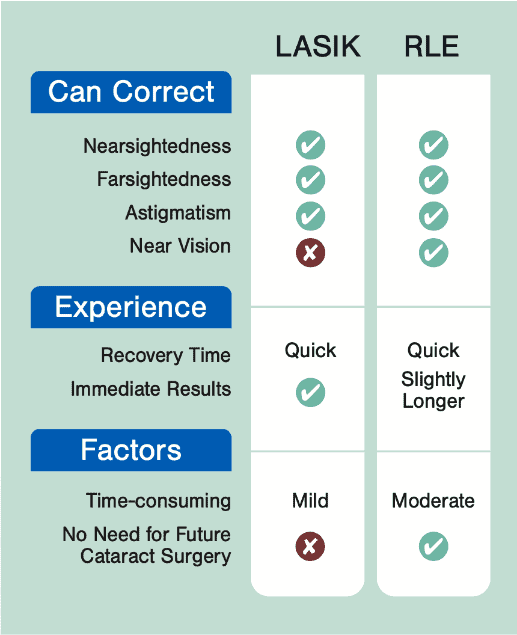LASIK or RLE?
Understanding Your Options
Many of us experience refractive errors such as nearsightedness, farsightedness, and astigmatism over our lives, causing our vision to be distorted and requiring glasses or contacts to see clearly. Some of us have enjoyed great natural vision their whole lives but notice changes in their vision after the age of 40.
 LASIK
LASIK
All-Laser LASIK reshapes the cornea with advanced laser technology.
![]() Treat both eyes at the same time
Treat both eyes at the same time
![]() Over 99% of our nearsighted patients see 20/20 or better
Over 99% of our nearsighted patients see 20/20 or better
![]() Accurate and safe
Accurate and safe
![]() Accurately corrects distance vision & astigmatism
Accurately corrects distance vision & astigmatism
![]() Cannot give range of focus. However, MonoVision LASIK is an option for those pre-adapted patients.
Cannot give range of focus. However, MonoVision LASIK is an option for those pre-adapted patients.
![]() Patients will eventually need cataract surgery
Patients will eventually need cataract surgery
 RLE
RLE
Refractive Lens Exchange replaces your eye’s natural lens with an intraocular lens (IOL).
![]() Same procedure as cataract surgery
Same procedure as cataract surgery
![]() Little to no dependence on glasses at all distances
Little to no dependence on glasses at all distances
![]() Your vision for life!
Your vision for life!
![]() Accurate and safe
Accurate and safe
![]() Patient will not need cataract surgery
Patient will not need cataract surgery
![]() Only performed on one eye at a time
Only performed on one eye at a time
![]() Potential for some rings around lights or glare
Potential for some rings around lights or glare

A Few Things to Consider
At what distance do you spend most of your visual time? Far for driving or watching TV? Intermediate for most computer work? Near for small print or working on numbers on a computer screen? What part of your life would be most improved by clear vision?
Patients nearing or already in their 50’s or 60’s should consider the longevity of their procedure. While LASIK is meant to be a permanent correction to the imperfections of their cornea, cataracts will eventually impair the vision and will need to be removed. However, cataracts can form at any time and cannot be predicted as to when that will occur.
The IOL will take longer for final clarity of vision, and inherent in some design of the lenses, there will be rings around lights or glare noticeable at night. For most patients, this lessens over time and does not interfere with their activities.
